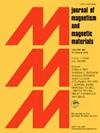Anisotropic model of nonlinear permanent magnets in finite element method software
IF 2.5
3区 材料科学
Q3 MATERIALS SCIENCE, MULTIDISCIPLINARY
引用次数: 0
Abstract
Rare earth elements are associated with many challenges, and therefore, rare earth free options are being investigated as an alternative. The further improvement of the electrical machines with rare earth free permanent magnets requires an accurate and efficient finite element method (FEM) model to predict and overcome the issues related to a low magnetic flux density or partial demagnetization of permanent magnets. The main challenges of the permanent magnet model development are related to the nonlinearity of the hysteresis loop in the operating region and permanent magnet anisotropy. The model presented in this paper is a dynamic model of anisotropic nonlinear permanent magnet (PM) developed in COMSOL Multiphysics 6.2 software. The model can be used for modelling magnetic materials with a hysteresis loop. Measurement results of Alnico 8 LNGT40 nonlinear permanent magnet were used in this model. The model includes all four quadrants of hysteresis loops, recoil lines, and knee points of preferred or easy (EA) and transverse or hard (HA) magnetization directions. It allows correct modelling of not only generators but also motors and memory machines. The flowcharts of the permanent magnet modelling logic were presented for both directions. Partial demagnetization in the preferred (EA) direction and partial magnetization in the transverse (HA) direction can be observed in the simulation results after the short circuit. Partial remagnetization of the magnet in the preferred (EA) direction and partial demagnetization in the transverse (HA) can be observed after applying a current with the same amplitude but in the opposite direction. The top part of the magnet was mostly affected by the magnetic field of the stator. Simulation results differ from the previous version of the magnet model. The new version of the model has a higher accuracy and shows higher demagnetization in the preferred (EA) direction than the previous version.
有限元法软件中的非线性永磁体各向异性模型
稀土元素与许多挑战相关,因此,人们正在研究不含稀土的替代方案。要进一步改进使用无稀土永磁体的电机,需要一个精确高效的有限元法(FEM)模型来预测和克服与永磁体低磁通密度或部分退磁相关的问题。永磁体模型开发的主要挑战与工作区域磁滞回线的非线性和永磁体各向异性有关。本文介绍的模型是在 COMSOL Multiphysics 6.2 软件中开发的各向异性非线性永磁体(PM)动态模型。该模型可用于具有磁滞回线的磁性材料建模。该模型使用了 Alnico 8 LNGT40 非线性永磁体的测量结果。该模型包括磁滞回线的所有四个象限、反冲线以及优先或易(EA)磁化方向和横向或硬(HA)磁化方向的膝点。它不仅能正确模拟发电机,还能正确模拟电机和记忆机。永磁建模逻辑的流程图针对这两个方向进行了介绍。在短路后的模拟结果中可以观察到优先(EA)方向的部分退磁和横向(HA)方向的部分磁化。在施加相同振幅但方向相反的电流后,可观察到磁体在优先(EA)方向的部分再磁化和横向(HA)的部分退磁。磁体顶部主要受到定子磁场的影响。模拟结果与之前版本的磁体模型有所不同。新版模型的精度更高,在优先(EA)方向上的退磁程度也高于旧版模型。
本文章由计算机程序翻译,如有差异,请以英文原文为准。
求助全文
约1分钟内获得全文
求助全文
来源期刊

Journal of Magnetism and Magnetic Materials
物理-材料科学:综合
CiteScore
5.30
自引率
11.10%
发文量
1149
审稿时长
59 days
期刊介绍:
The Journal of Magnetism and Magnetic Materials provides an important forum for the disclosure and discussion of original contributions covering the whole spectrum of topics, from basic magnetism to the technology and applications of magnetic materials. The journal encourages greater interaction between the basic and applied sub-disciplines of magnetism with comprehensive review articles, in addition to full-length contributions. In addition, other categories of contributions are welcome, including Critical Focused issues, Current Perspectives and Outreach to the General Public.
Main Categories:
Full-length articles:
Technically original research documents that report results of value to the communities that comprise the journal audience. The link between chemical, structural and microstructural properties on the one hand and magnetic properties on the other hand are encouraged.
In addition to general topics covering all areas of magnetism and magnetic materials, the full-length articles also include three sub-sections, focusing on Nanomagnetism, Spintronics and Applications.
The sub-section on Nanomagnetism contains articles on magnetic nanoparticles, nanowires, thin films, 2D materials and other nanoscale magnetic materials and their applications.
The sub-section on Spintronics contains articles on magnetoresistance, magnetoimpedance, magneto-optical phenomena, Micro-Electro-Mechanical Systems (MEMS), and other topics related to spin current control and magneto-transport phenomena. The sub-section on Applications display papers that focus on applications of magnetic materials. The applications need to show a connection to magnetism.
Review articles:
Review articles organize, clarify, and summarize existing major works in the areas covered by the Journal and provide comprehensive citations to the full spectrum of relevant literature.
 求助内容:
求助内容: 应助结果提醒方式:
应助结果提醒方式:


